Clinical Governance: Quality, Management, and Healthcare Outcomes
VerifiedAdded on 2023/01/19
|12
|3190
|80
Report
AI Summary
This report delves into the multifaceted concept of clinical governance within healthcare, exploring its origins, relevance, and core components such as risk management, clinical audit, and continuous professional development. It examines specific actions used to monitor quality and safety, emphasizing the importance of patient-centered care and the integration of governance and management to ensure optimal healthcare outcomes. The report highlights the significance of Iwi primary health care, addressing cultural differences and health promotion strategies. Finally, it provides a personal reflective discussion on the impact of clinical governance on the author's profession as a dentist, underscoring the importance of continuous learning and technological advancements in enhancing patient care.
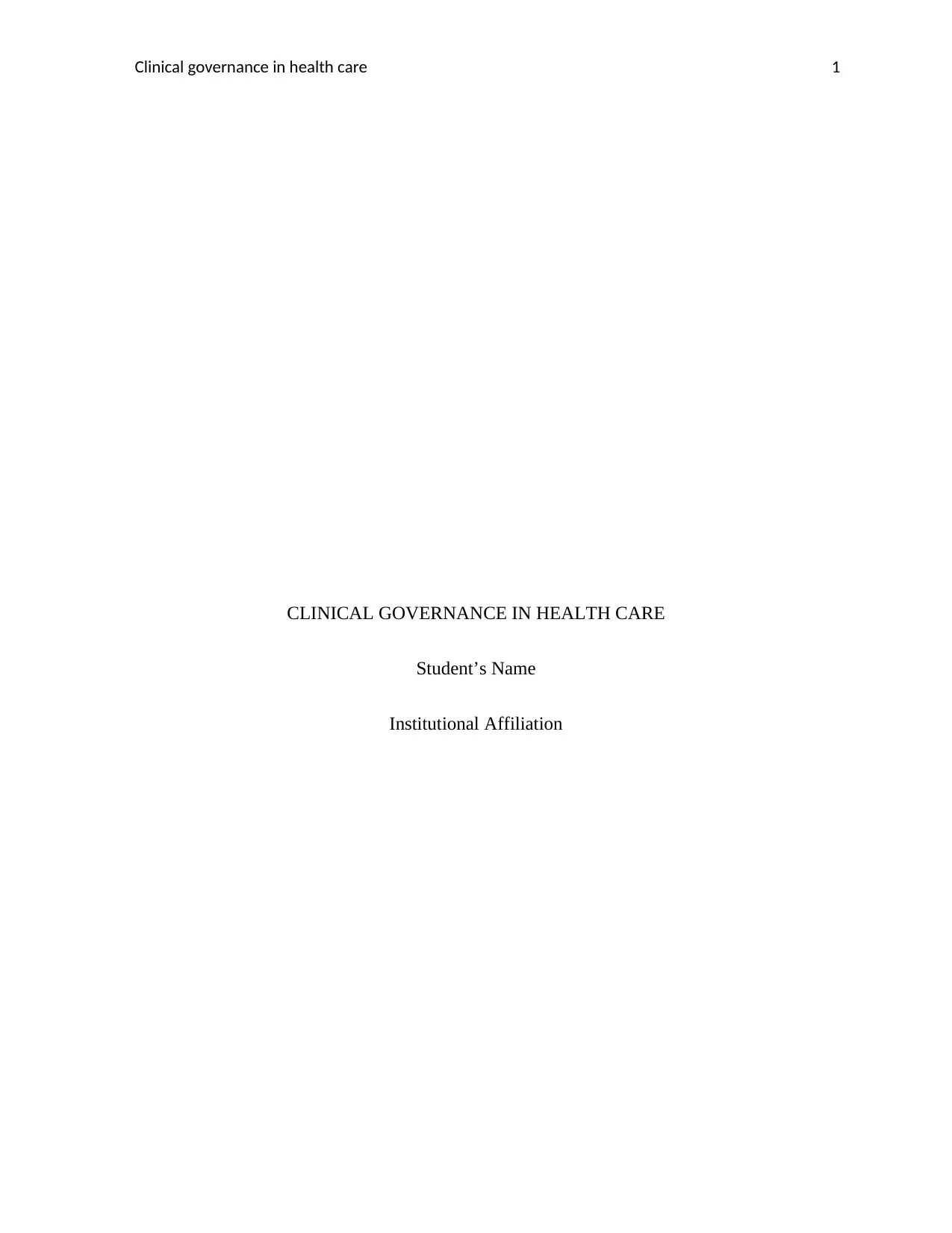
Clinical governance in health care 1
CLINICAL GOVERNANCE IN HEALTH CARE
Student’s Name
Institutional Affiliation
CLINICAL GOVERNANCE IN HEALTH CARE
Student’s Name
Institutional Affiliation
Paraphrase This Document
Need a fresh take? Get an instant paraphrase of this document with our AI Paraphraser
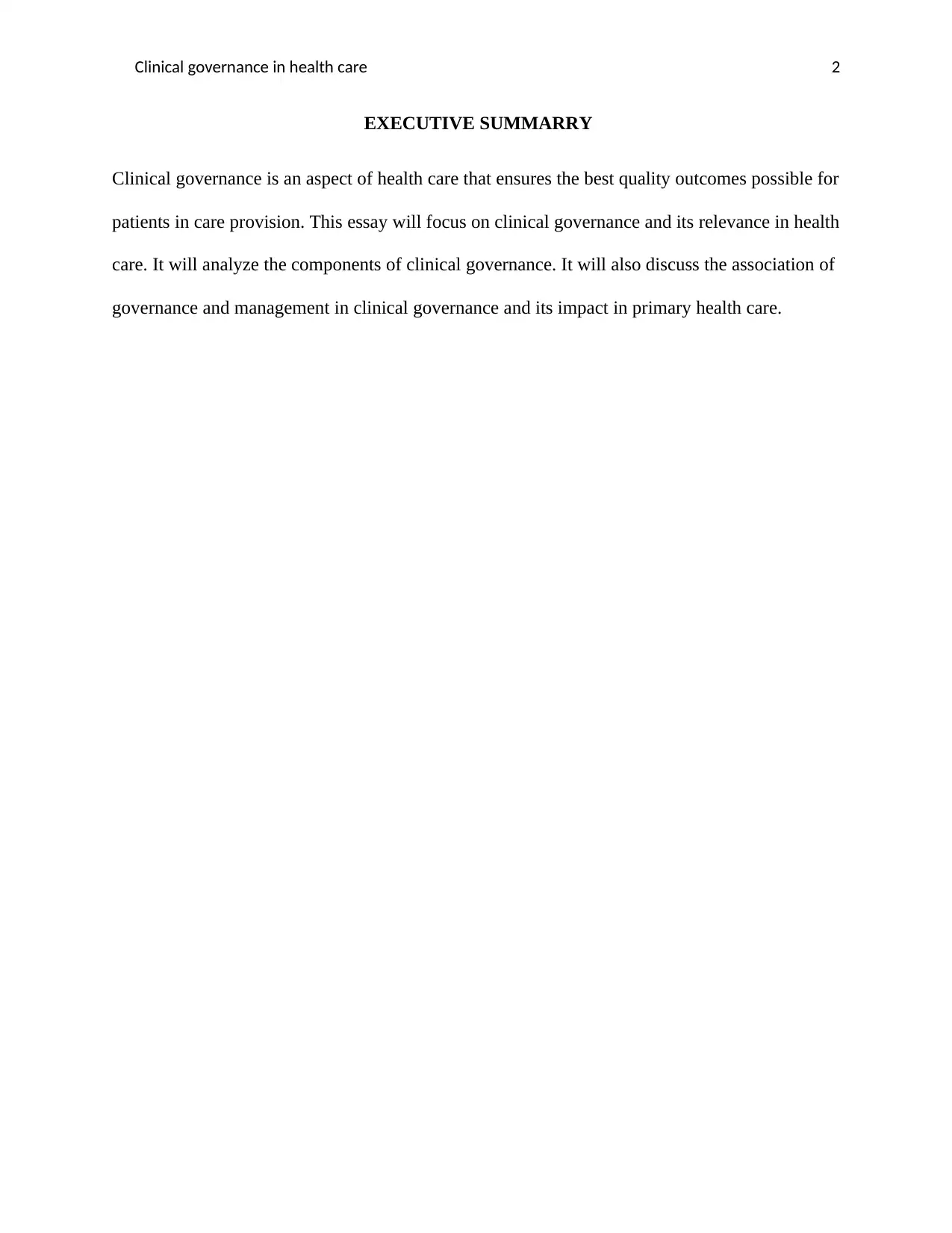
Clinical governance in health care 2
EXECUTIVE SUMMARRY
Clinical governance is an aspect of health care that ensures the best quality outcomes possible for
patients in care provision. This essay will focus on clinical governance and its relevance in health
care. It will analyze the components of clinical governance. It will also discuss the association of
governance and management in clinical governance and its impact in primary health care.
EXECUTIVE SUMMARRY
Clinical governance is an aspect of health care that ensures the best quality outcomes possible for
patients in care provision. This essay will focus on clinical governance and its relevance in health
care. It will analyze the components of clinical governance. It will also discuss the association of
governance and management in clinical governance and its impact in primary health care.
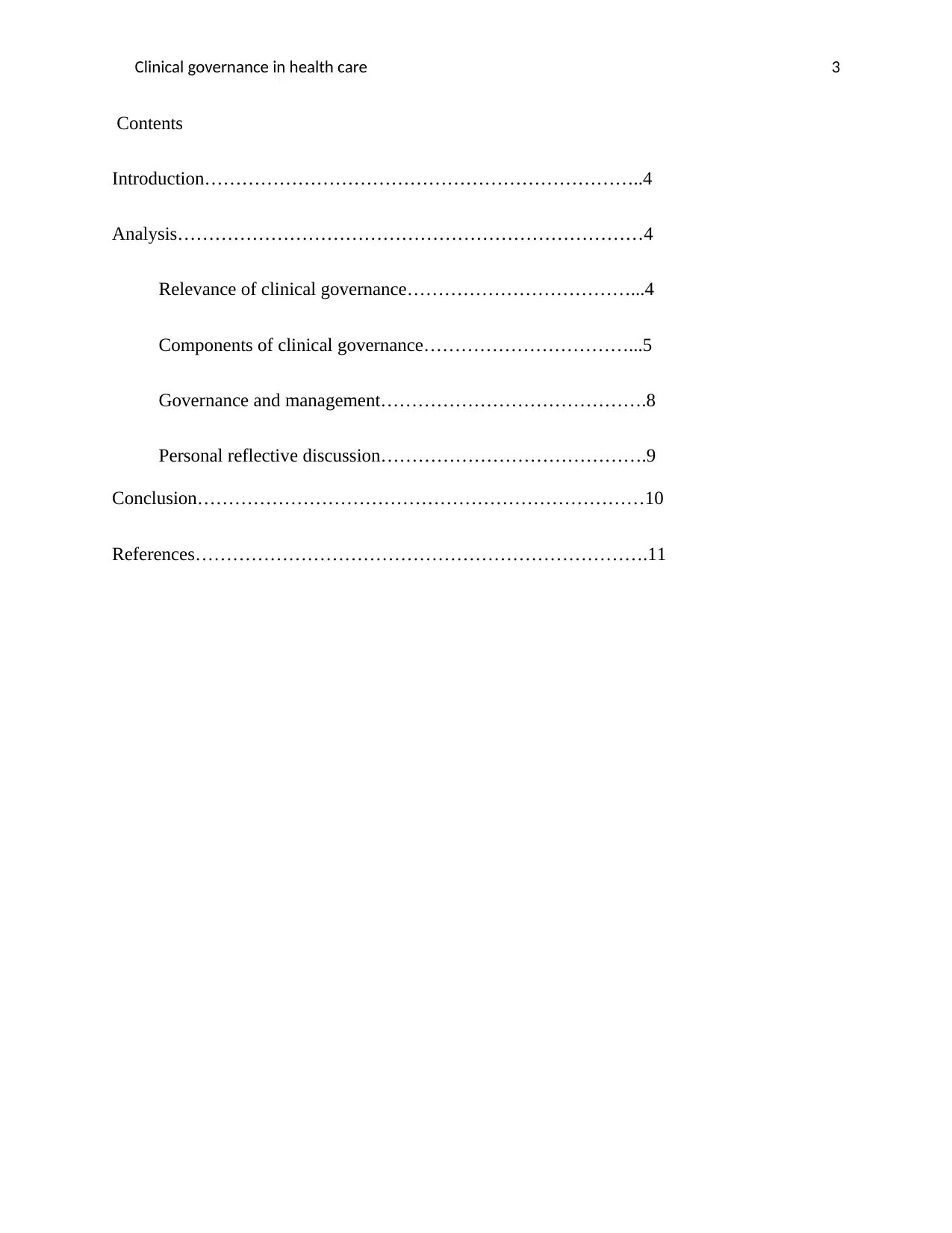
Clinical governance in health care 3
Contents
Introduction……………………………………………………………..4
Analysis…………………………………………………………………4
Relevance of clinical governance………………………………...4
Components of clinical governance……………………………...5
Governance and management…………………………………….8
Personal reflective discussion…………………………………….9
Conclusion………………………………………………………………10
References……………………………………………………………….11
Contents
Introduction……………………………………………………………..4
Analysis…………………………………………………………………4
Relevance of clinical governance………………………………...4
Components of clinical governance……………………………...5
Governance and management…………………………………….8
Personal reflective discussion…………………………………….9
Conclusion………………………………………………………………10
References……………………………………………………………….11
⊘ This is a preview!⊘
Do you want full access?
Subscribe today to unlock all pages.

Trusted by 1+ million students worldwide
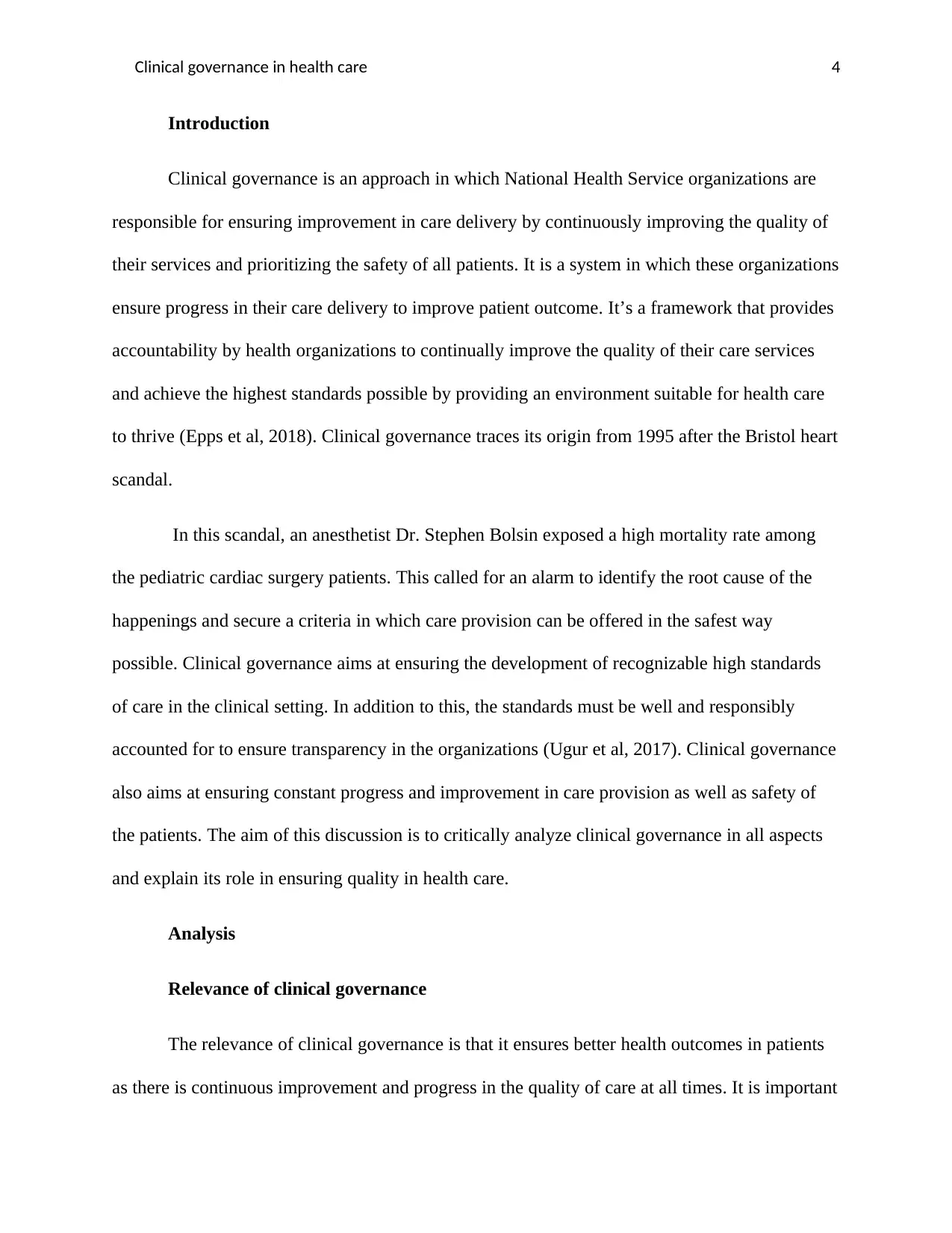
Clinical governance in health care 4
Introduction
Clinical governance is an approach in which National Health Service organizations are
responsible for ensuring improvement in care delivery by continuously improving the quality of
their services and prioritizing the safety of all patients. It is a system in which these organizations
ensure progress in their care delivery to improve patient outcome. It’s a framework that provides
accountability by health organizations to continually improve the quality of their care services
and achieve the highest standards possible by providing an environment suitable for health care
to thrive (Epps et al, 2018). Clinical governance traces its origin from 1995 after the Bristol heart
scandal.
In this scandal, an anesthetist Dr. Stephen Bolsin exposed a high mortality rate among
the pediatric cardiac surgery patients. This called for an alarm to identify the root cause of the
happenings and secure a criteria in which care provision can be offered in the safest way
possible. Clinical governance aims at ensuring the development of recognizable high standards
of care in the clinical setting. In addition to this, the standards must be well and responsibly
accounted for to ensure transparency in the organizations (Ugur et al, 2017). Clinical governance
also aims at ensuring constant progress and improvement in care provision as well as safety of
the patients. The aim of this discussion is to critically analyze clinical governance in all aspects
and explain its role in ensuring quality in health care.
Analysis
Relevance of clinical governance
The relevance of clinical governance is that it ensures better health outcomes in patients
as there is continuous improvement and progress in the quality of care at all times. It is important
Introduction
Clinical governance is an approach in which National Health Service organizations are
responsible for ensuring improvement in care delivery by continuously improving the quality of
their services and prioritizing the safety of all patients. It is a system in which these organizations
ensure progress in their care delivery to improve patient outcome. It’s a framework that provides
accountability by health organizations to continually improve the quality of their care services
and achieve the highest standards possible by providing an environment suitable for health care
to thrive (Epps et al, 2018). Clinical governance traces its origin from 1995 after the Bristol heart
scandal.
In this scandal, an anesthetist Dr. Stephen Bolsin exposed a high mortality rate among
the pediatric cardiac surgery patients. This called for an alarm to identify the root cause of the
happenings and secure a criteria in which care provision can be offered in the safest way
possible. Clinical governance aims at ensuring the development of recognizable high standards
of care in the clinical setting. In addition to this, the standards must be well and responsibly
accounted for to ensure transparency in the organizations (Ugur et al, 2017). Clinical governance
also aims at ensuring constant progress and improvement in care provision as well as safety of
the patients. The aim of this discussion is to critically analyze clinical governance in all aspects
and explain its role in ensuring quality in health care.
Analysis
Relevance of clinical governance
The relevance of clinical governance is that it ensures better health outcomes in patients
as there is continuous improvement and progress in the quality of care at all times. It is important
Paraphrase This Document
Need a fresh take? Get an instant paraphrase of this document with our AI Paraphraser
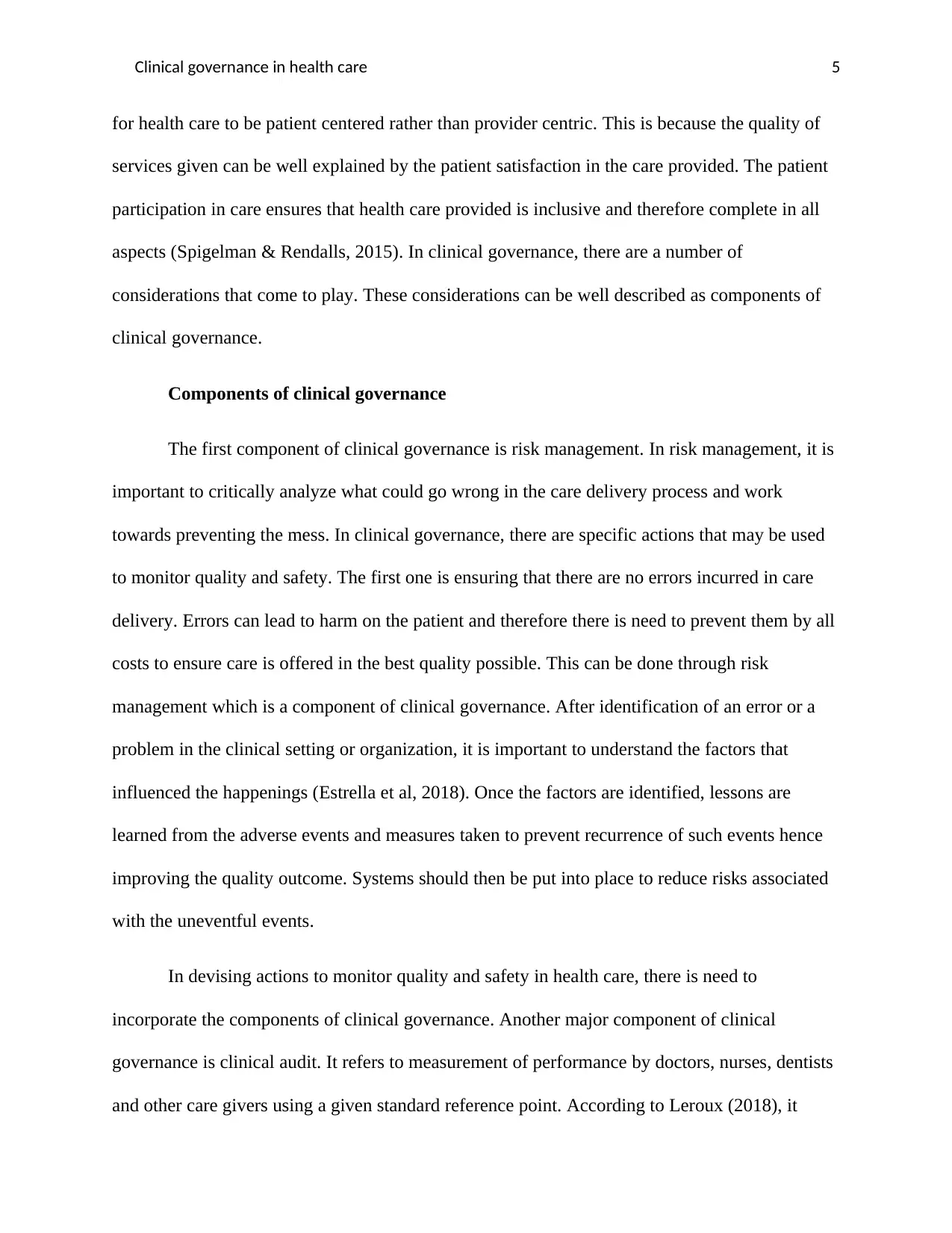
Clinical governance in health care 5
for health care to be patient centered rather than provider centric. This is because the quality of
services given can be well explained by the patient satisfaction in the care provided. The patient
participation in care ensures that health care provided is inclusive and therefore complete in all
aspects (Spigelman & Rendalls, 2015). In clinical governance, there are a number of
considerations that come to play. These considerations can be well described as components of
clinical governance.
Components of clinical governance
The first component of clinical governance is risk management. In risk management, it is
important to critically analyze what could go wrong in the care delivery process and work
towards preventing the mess. In clinical governance, there are specific actions that may be used
to monitor quality and safety. The first one is ensuring that there are no errors incurred in care
delivery. Errors can lead to harm on the patient and therefore there is need to prevent them by all
costs to ensure care is offered in the best quality possible. This can be done through risk
management which is a component of clinical governance. After identification of an error or a
problem in the clinical setting or organization, it is important to understand the factors that
influenced the happenings (Estrella et al, 2018). Once the factors are identified, lessons are
learned from the adverse events and measures taken to prevent recurrence of such events hence
improving the quality outcome. Systems should then be put into place to reduce risks associated
with the uneventful events.
In devising actions to monitor quality and safety in health care, there is need to
incorporate the components of clinical governance. Another major component of clinical
governance is clinical audit. It refers to measurement of performance by doctors, nurses, dentists
and other care givers using a given standard reference point. According to Leroux (2018), it
for health care to be patient centered rather than provider centric. This is because the quality of
services given can be well explained by the patient satisfaction in the care provided. The patient
participation in care ensures that health care provided is inclusive and therefore complete in all
aspects (Spigelman & Rendalls, 2015). In clinical governance, there are a number of
considerations that come to play. These considerations can be well described as components of
clinical governance.
Components of clinical governance
The first component of clinical governance is risk management. In risk management, it is
important to critically analyze what could go wrong in the care delivery process and work
towards preventing the mess. In clinical governance, there are specific actions that may be used
to monitor quality and safety. The first one is ensuring that there are no errors incurred in care
delivery. Errors can lead to harm on the patient and therefore there is need to prevent them by all
costs to ensure care is offered in the best quality possible. This can be done through risk
management which is a component of clinical governance. After identification of an error or a
problem in the clinical setting or organization, it is important to understand the factors that
influenced the happenings (Estrella et al, 2018). Once the factors are identified, lessons are
learned from the adverse events and measures taken to prevent recurrence of such events hence
improving the quality outcome. Systems should then be put into place to reduce risks associated
with the uneventful events.
In devising actions to monitor quality and safety in health care, there is need to
incorporate the components of clinical governance. Another major component of clinical
governance is clinical audit. It refers to measurement of performance by doctors, nurses, dentists
and other care givers using a given standard reference point. According to Leroux (2018), it
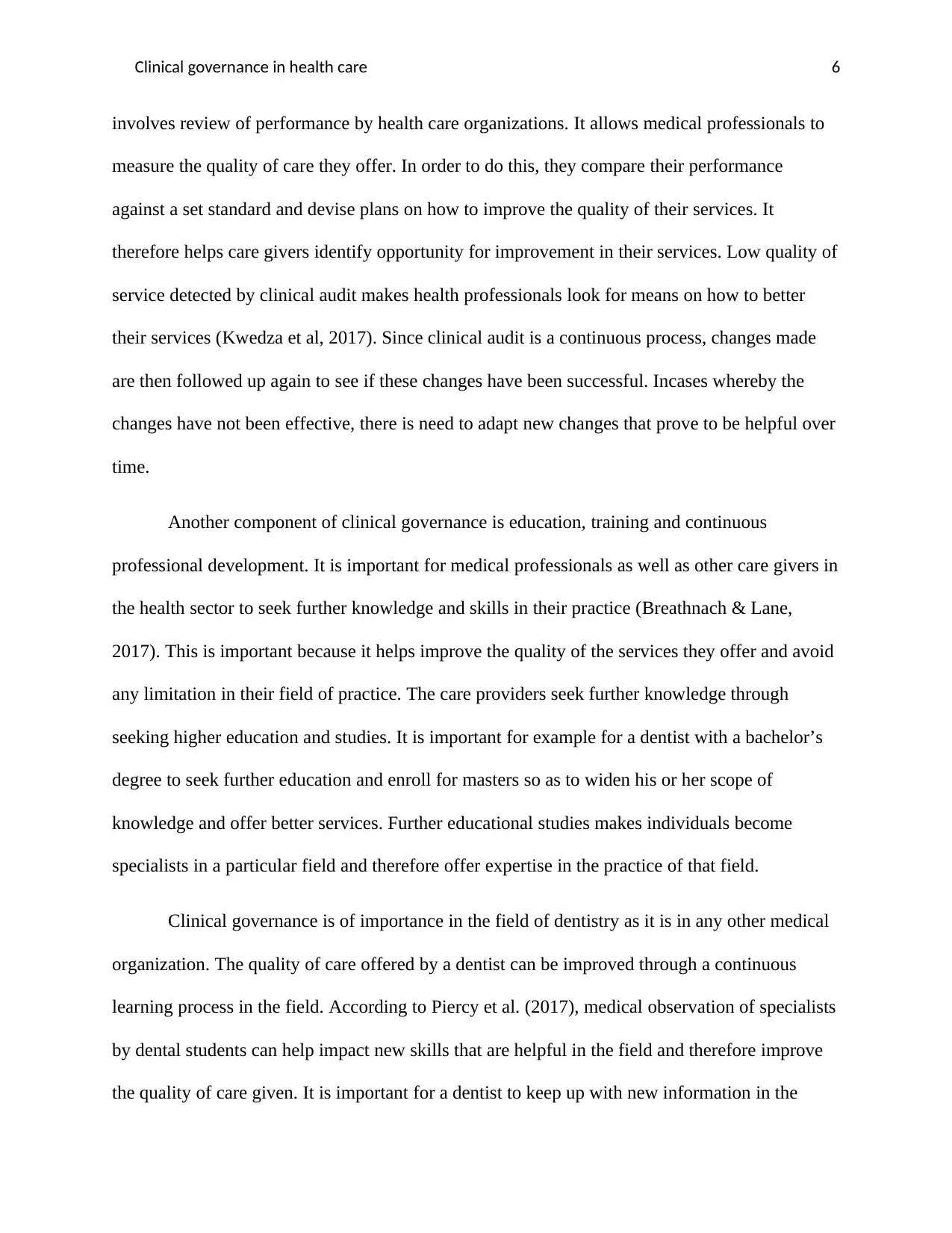
Clinical governance in health care 6
involves review of performance by health care organizations. It allows medical professionals to
measure the quality of care they offer. In order to do this, they compare their performance
against a set standard and devise plans on how to improve the quality of their services. It
therefore helps care givers identify opportunity for improvement in their services. Low quality of
service detected by clinical audit makes health professionals look for means on how to better
their services (Kwedza et al, 2017). Since clinical audit is a continuous process, changes made
are then followed up again to see if these changes have been successful. Incases whereby the
changes have not been effective, there is need to adapt new changes that prove to be helpful over
time.
Another component of clinical governance is education, training and continuous
professional development. It is important for medical professionals as well as other care givers in
the health sector to seek further knowledge and skills in their practice (Breathnach & Lane,
2017). This is important because it helps improve the quality of the services they offer and avoid
any limitation in their field of practice. The care providers seek further knowledge through
seeking higher education and studies. It is important for example for a dentist with a bachelor’s
degree to seek further education and enroll for masters so as to widen his or her scope of
knowledge and offer better services. Further educational studies makes individuals become
specialists in a particular field and therefore offer expertise in the practice of that field.
Clinical governance is of importance in the field of dentistry as it is in any other medical
organization. The quality of care offered by a dentist can be improved through a continuous
learning process in the field. According to Piercy et al. (2017), medical observation of specialists
by dental students can help impact new skills that are helpful in the field and therefore improve
the quality of care given. It is important for a dentist to keep up with new information in the
involves review of performance by health care organizations. It allows medical professionals to
measure the quality of care they offer. In order to do this, they compare their performance
against a set standard and devise plans on how to improve the quality of their services. It
therefore helps care givers identify opportunity for improvement in their services. Low quality of
service detected by clinical audit makes health professionals look for means on how to better
their services (Kwedza et al, 2017). Since clinical audit is a continuous process, changes made
are then followed up again to see if these changes have been successful. Incases whereby the
changes have not been effective, there is need to adapt new changes that prove to be helpful over
time.
Another component of clinical governance is education, training and continuous
professional development. It is important for medical professionals as well as other care givers in
the health sector to seek further knowledge and skills in their practice (Breathnach & Lane,
2017). This is important because it helps improve the quality of the services they offer and avoid
any limitation in their field of practice. The care providers seek further knowledge through
seeking higher education and studies. It is important for example for a dentist with a bachelor’s
degree to seek further education and enroll for masters so as to widen his or her scope of
knowledge and offer better services. Further educational studies makes individuals become
specialists in a particular field and therefore offer expertise in the practice of that field.
Clinical governance is of importance in the field of dentistry as it is in any other medical
organization. The quality of care offered by a dentist can be improved through a continuous
learning process in the field. According to Piercy et al. (2017), medical observation of specialists
by dental students can help impact new skills that are helpful in the field and therefore improve
the quality of care given. It is important for a dentist to keep up with new information in the
⊘ This is a preview!⊘
Do you want full access?
Subscribe today to unlock all pages.

Trusted by 1+ million students worldwide
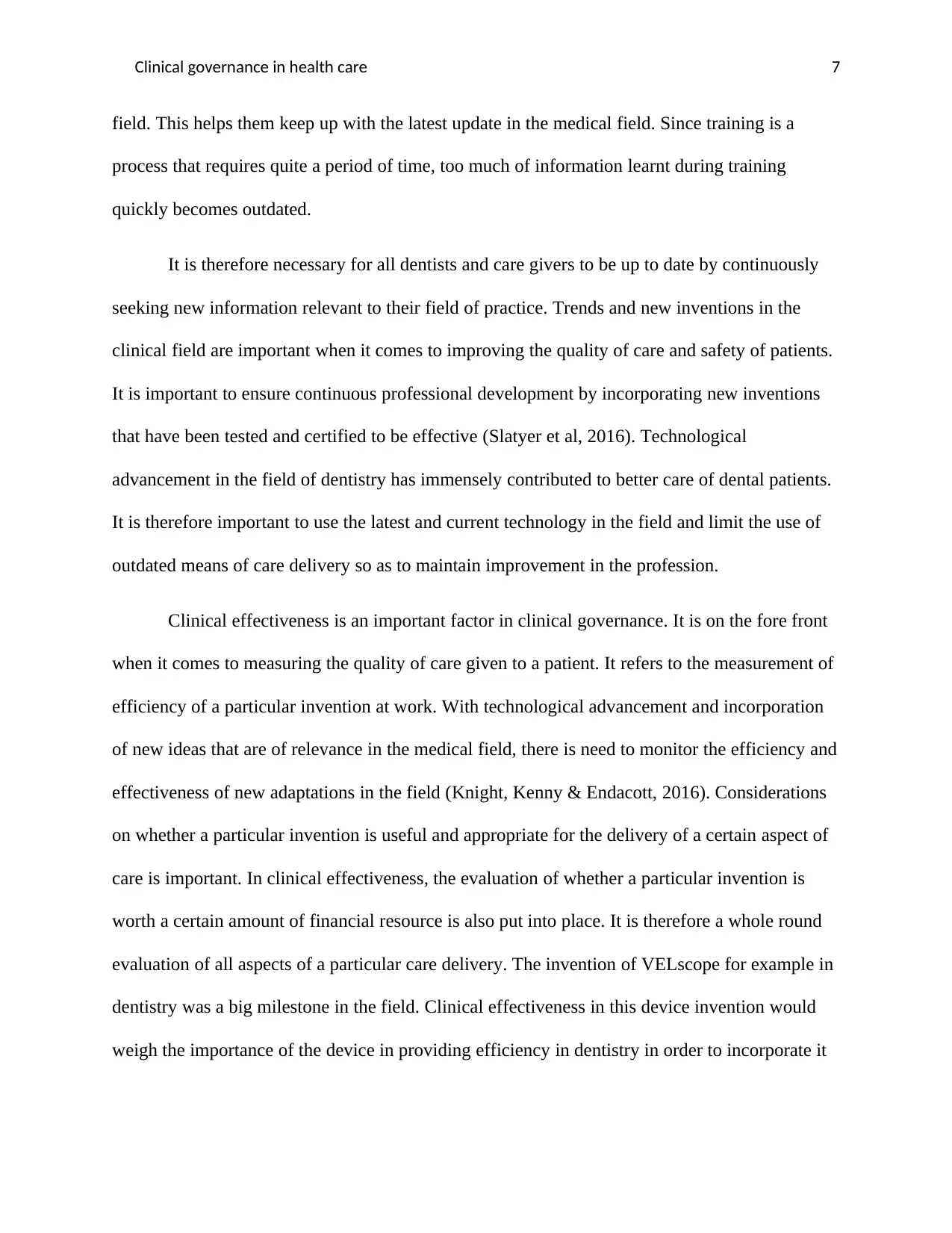
Clinical governance in health care 7
field. This helps them keep up with the latest update in the medical field. Since training is a
process that requires quite a period of time, too much of information learnt during training
quickly becomes outdated.
It is therefore necessary for all dentists and care givers to be up to date by continuously
seeking new information relevant to their field of practice. Trends and new inventions in the
clinical field are important when it comes to improving the quality of care and safety of patients.
It is important to ensure continuous professional development by incorporating new inventions
that have been tested and certified to be effective (Slatyer et al, 2016). Technological
advancement in the field of dentistry has immensely contributed to better care of dental patients.
It is therefore important to use the latest and current technology in the field and limit the use of
outdated means of care delivery so as to maintain improvement in the profession.
Clinical effectiveness is an important factor in clinical governance. It is on the fore front
when it comes to measuring the quality of care given to a patient. It refers to the measurement of
efficiency of a particular invention at work. With technological advancement and incorporation
of new ideas that are of relevance in the medical field, there is need to monitor the efficiency and
effectiveness of new adaptations in the field (Knight, Kenny & Endacott, 2016). Considerations
on whether a particular invention is useful and appropriate for the delivery of a certain aspect of
care is important. In clinical effectiveness, the evaluation of whether a particular invention is
worth a certain amount of financial resource is also put into place. It is therefore a whole round
evaluation of all aspects of a particular care delivery. The invention of VELscope for example in
dentistry was a big milestone in the field. Clinical effectiveness in this device invention would
weigh the importance of the device in providing efficiency in dentistry in order to incorporate it
field. This helps them keep up with the latest update in the medical field. Since training is a
process that requires quite a period of time, too much of information learnt during training
quickly becomes outdated.
It is therefore necessary for all dentists and care givers to be up to date by continuously
seeking new information relevant to their field of practice. Trends and new inventions in the
clinical field are important when it comes to improving the quality of care and safety of patients.
It is important to ensure continuous professional development by incorporating new inventions
that have been tested and certified to be effective (Slatyer et al, 2016). Technological
advancement in the field of dentistry has immensely contributed to better care of dental patients.
It is therefore important to use the latest and current technology in the field and limit the use of
outdated means of care delivery so as to maintain improvement in the profession.
Clinical effectiveness is an important factor in clinical governance. It is on the fore front
when it comes to measuring the quality of care given to a patient. It refers to the measurement of
efficiency of a particular invention at work. With technological advancement and incorporation
of new ideas that are of relevance in the medical field, there is need to monitor the efficiency and
effectiveness of new adaptations in the field (Knight, Kenny & Endacott, 2016). Considerations
on whether a particular invention is useful and appropriate for the delivery of a certain aspect of
care is important. In clinical effectiveness, the evaluation of whether a particular invention is
worth a certain amount of financial resource is also put into place. It is therefore a whole round
evaluation of all aspects of a particular care delivery. The invention of VELscope for example in
dentistry was a big milestone in the field. Clinical effectiveness in this device invention would
weigh the importance of the device in providing efficiency in dentistry in order to incorporate it
Paraphrase This Document
Need a fresh take? Get an instant paraphrase of this document with our AI Paraphraser
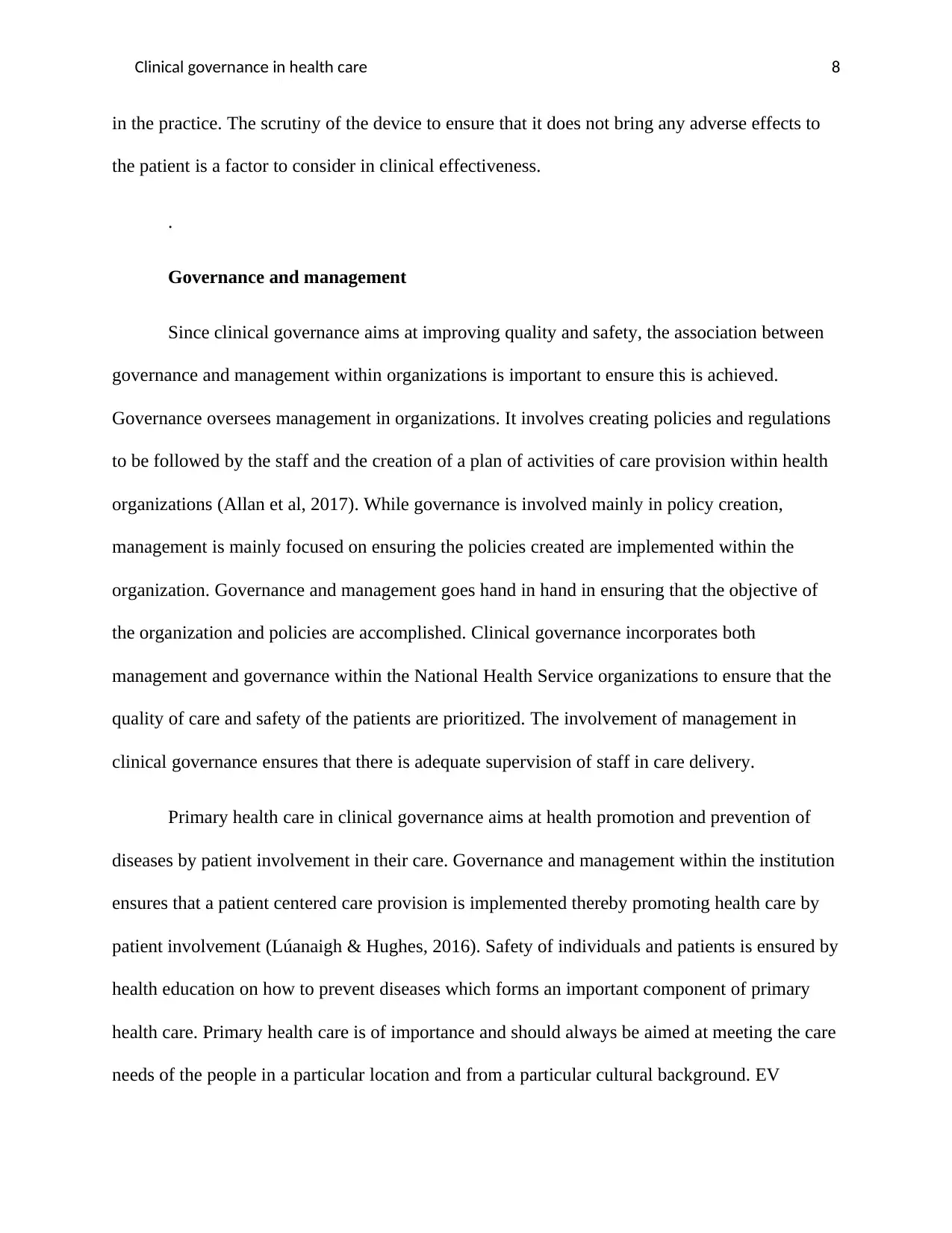
Clinical governance in health care 8
in the practice. The scrutiny of the device to ensure that it does not bring any adverse effects to
the patient is a factor to consider in clinical effectiveness.
.
Governance and management
Since clinical governance aims at improving quality and safety, the association between
governance and management within organizations is important to ensure this is achieved.
Governance oversees management in organizations. It involves creating policies and regulations
to be followed by the staff and the creation of a plan of activities of care provision within health
organizations (Allan et al, 2017). While governance is involved mainly in policy creation,
management is mainly focused on ensuring the policies created are implemented within the
organization. Governance and management goes hand in hand in ensuring that the objective of
the organization and policies are accomplished. Clinical governance incorporates both
management and governance within the National Health Service organizations to ensure that the
quality of care and safety of the patients are prioritized. The involvement of management in
clinical governance ensures that there is adequate supervision of staff in care delivery.
Primary health care in clinical governance aims at health promotion and prevention of
diseases by patient involvement in their care. Governance and management within the institution
ensures that a patient centered care provision is implemented thereby promoting health care by
patient involvement (Lúanaigh & Hughes, 2016). Safety of individuals and patients is ensured by
health education on how to prevent diseases which forms an important component of primary
health care. Primary health care is of importance and should always be aimed at meeting the care
needs of the people in a particular location and from a particular cultural background. EV
in the practice. The scrutiny of the device to ensure that it does not bring any adverse effects to
the patient is a factor to consider in clinical effectiveness.
.
Governance and management
Since clinical governance aims at improving quality and safety, the association between
governance and management within organizations is important to ensure this is achieved.
Governance oversees management in organizations. It involves creating policies and regulations
to be followed by the staff and the creation of a plan of activities of care provision within health
organizations (Allan et al, 2017). While governance is involved mainly in policy creation,
management is mainly focused on ensuring the policies created are implemented within the
organization. Governance and management goes hand in hand in ensuring that the objective of
the organization and policies are accomplished. Clinical governance incorporates both
management and governance within the National Health Service organizations to ensure that the
quality of care and safety of the patients are prioritized. The involvement of management in
clinical governance ensures that there is adequate supervision of staff in care delivery.
Primary health care in clinical governance aims at health promotion and prevention of
diseases by patient involvement in their care. Governance and management within the institution
ensures that a patient centered care provision is implemented thereby promoting health care by
patient involvement (Lúanaigh & Hughes, 2016). Safety of individuals and patients is ensured by
health education on how to prevent diseases which forms an important component of primary
health care. Primary health care is of importance and should always be aimed at meeting the care
needs of the people in a particular location and from a particular cultural background. EV
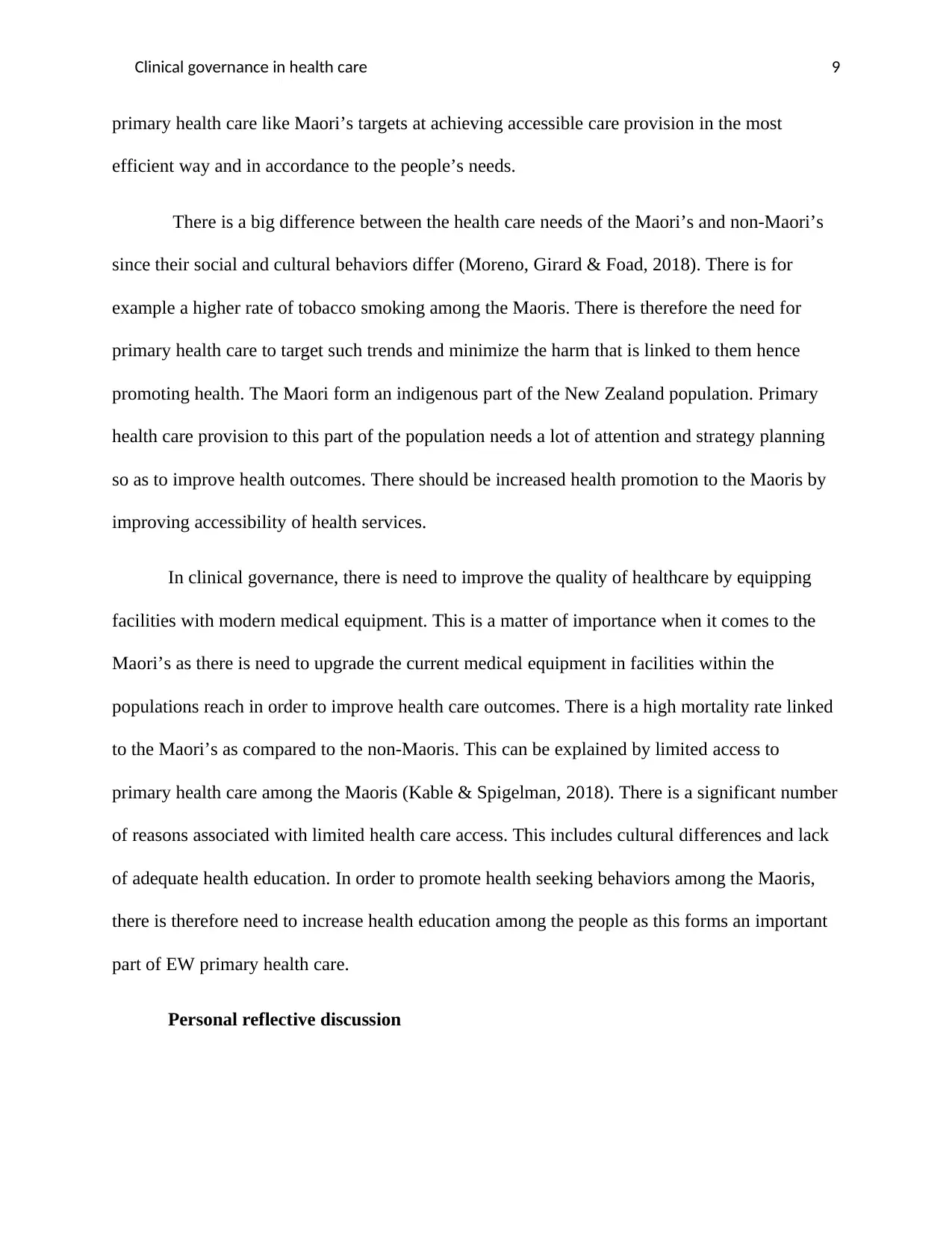
Clinical governance in health care 9
primary health care like Maori’s targets at achieving accessible care provision in the most
efficient way and in accordance to the people’s needs.
There is a big difference between the health care needs of the Maori’s and non-Maori’s
since their social and cultural behaviors differ (Moreno, Girard & Foad, 2018). There is for
example a higher rate of tobacco smoking among the Maoris. There is therefore the need for
primary health care to target such trends and minimize the harm that is linked to them hence
promoting health. The Maori form an indigenous part of the New Zealand population. Primary
health care provision to this part of the population needs a lot of attention and strategy planning
so as to improve health outcomes. There should be increased health promotion to the Maoris by
improving accessibility of health services.
In clinical governance, there is need to improve the quality of healthcare by equipping
facilities with modern medical equipment. This is a matter of importance when it comes to the
Maori’s as there is need to upgrade the current medical equipment in facilities within the
populations reach in order to improve health care outcomes. There is a high mortality rate linked
to the Maori’s as compared to the non-Maoris. This can be explained by limited access to
primary health care among the Maoris (Kable & Spigelman, 2018). There is a significant number
of reasons associated with limited health care access. This includes cultural differences and lack
of adequate health education. In order to promote health seeking behaviors among the Maoris,
there is therefore need to increase health education among the people as this forms an important
part of EW primary health care.
Personal reflective discussion
primary health care like Maori’s targets at achieving accessible care provision in the most
efficient way and in accordance to the people’s needs.
There is a big difference between the health care needs of the Maori’s and non-Maori’s
since their social and cultural behaviors differ (Moreno, Girard & Foad, 2018). There is for
example a higher rate of tobacco smoking among the Maoris. There is therefore the need for
primary health care to target such trends and minimize the harm that is linked to them hence
promoting health. The Maori form an indigenous part of the New Zealand population. Primary
health care provision to this part of the population needs a lot of attention and strategy planning
so as to improve health outcomes. There should be increased health promotion to the Maoris by
improving accessibility of health services.
In clinical governance, there is need to improve the quality of healthcare by equipping
facilities with modern medical equipment. This is a matter of importance when it comes to the
Maori’s as there is need to upgrade the current medical equipment in facilities within the
populations reach in order to improve health care outcomes. There is a high mortality rate linked
to the Maori’s as compared to the non-Maoris. This can be explained by limited access to
primary health care among the Maoris (Kable & Spigelman, 2018). There is a significant number
of reasons associated with limited health care access. This includes cultural differences and lack
of adequate health education. In order to promote health seeking behaviors among the Maoris,
there is therefore need to increase health education among the people as this forms an important
part of EW primary health care.
Personal reflective discussion
⊘ This is a preview!⊘
Do you want full access?
Subscribe today to unlock all pages.

Trusted by 1+ million students worldwide
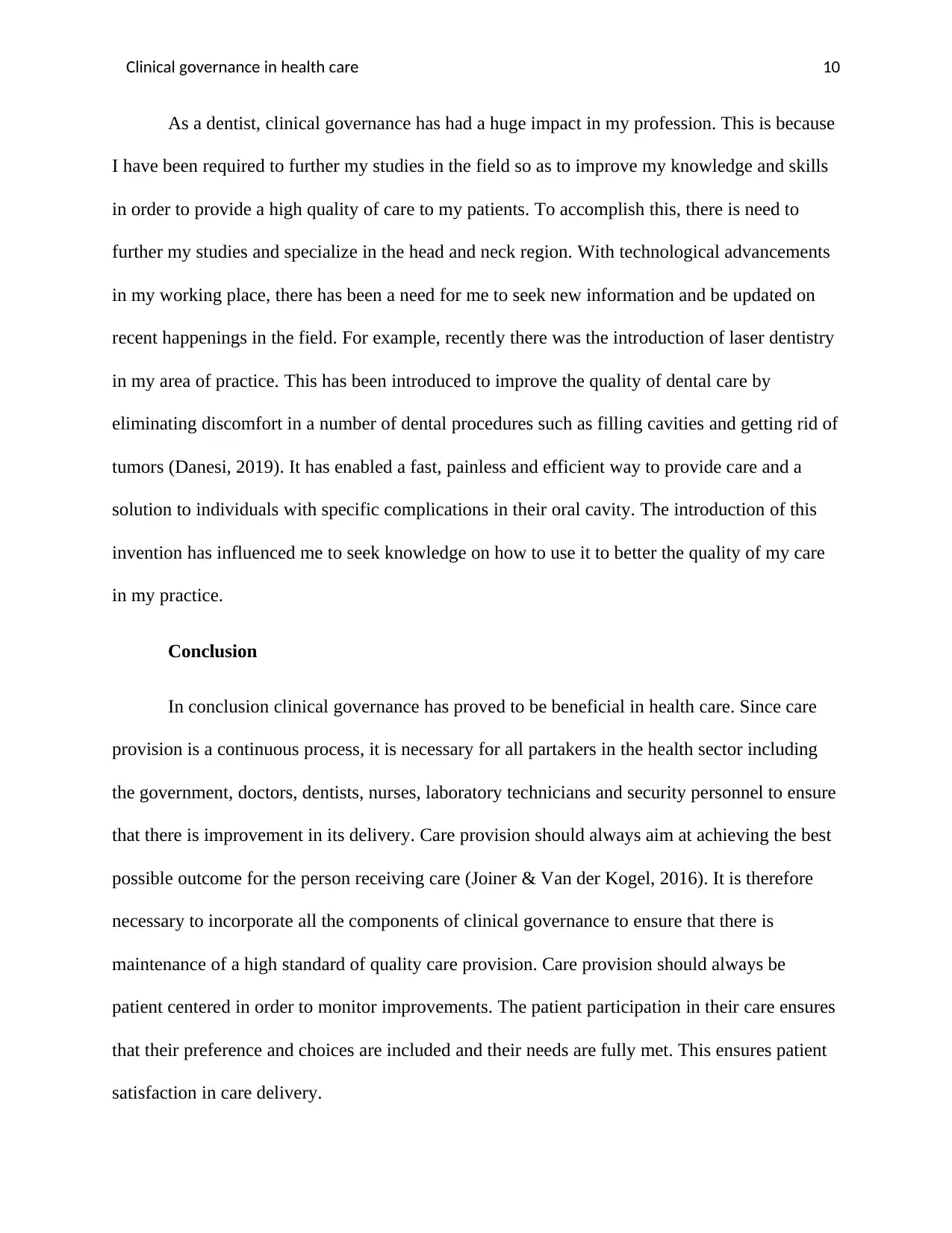
Clinical governance in health care 10
As a dentist, clinical governance has had a huge impact in my profession. This is because
I have been required to further my studies in the field so as to improve my knowledge and skills
in order to provide a high quality of care to my patients. To accomplish this, there is need to
further my studies and specialize in the head and neck region. With technological advancements
in my working place, there has been a need for me to seek new information and be updated on
recent happenings in the field. For example, recently there was the introduction of laser dentistry
in my area of practice. This has been introduced to improve the quality of dental care by
eliminating discomfort in a number of dental procedures such as filling cavities and getting rid of
tumors (Danesi, 2019). It has enabled a fast, painless and efficient way to provide care and a
solution to individuals with specific complications in their oral cavity. The introduction of this
invention has influenced me to seek knowledge on how to use it to better the quality of my care
in my practice.
Conclusion
In conclusion clinical governance has proved to be beneficial in health care. Since care
provision is a continuous process, it is necessary for all partakers in the health sector including
the government, doctors, dentists, nurses, laboratory technicians and security personnel to ensure
that there is improvement in its delivery. Care provision should always aim at achieving the best
possible outcome for the person receiving care (Joiner & Van der Kogel, 2016). It is therefore
necessary to incorporate all the components of clinical governance to ensure that there is
maintenance of a high standard of quality care provision. Care provision should always be
patient centered in order to monitor improvements. The patient participation in their care ensures
that their preference and choices are included and their needs are fully met. This ensures patient
satisfaction in care delivery.
As a dentist, clinical governance has had a huge impact in my profession. This is because
I have been required to further my studies in the field so as to improve my knowledge and skills
in order to provide a high quality of care to my patients. To accomplish this, there is need to
further my studies and specialize in the head and neck region. With technological advancements
in my working place, there has been a need for me to seek new information and be updated on
recent happenings in the field. For example, recently there was the introduction of laser dentistry
in my area of practice. This has been introduced to improve the quality of dental care by
eliminating discomfort in a number of dental procedures such as filling cavities and getting rid of
tumors (Danesi, 2019). It has enabled a fast, painless and efficient way to provide care and a
solution to individuals with specific complications in their oral cavity. The introduction of this
invention has influenced me to seek knowledge on how to use it to better the quality of my care
in my practice.
Conclusion
In conclusion clinical governance has proved to be beneficial in health care. Since care
provision is a continuous process, it is necessary for all partakers in the health sector including
the government, doctors, dentists, nurses, laboratory technicians and security personnel to ensure
that there is improvement in its delivery. Care provision should always aim at achieving the best
possible outcome for the person receiving care (Joiner & Van der Kogel, 2016). It is therefore
necessary to incorporate all the components of clinical governance to ensure that there is
maintenance of a high standard of quality care provision. Care provision should always be
patient centered in order to monitor improvements. The patient participation in their care ensures
that their preference and choices are included and their needs are fully met. This ensures patient
satisfaction in care delivery.
Paraphrase This Document
Need a fresh take? Get an instant paraphrase of this document with our AI Paraphraser
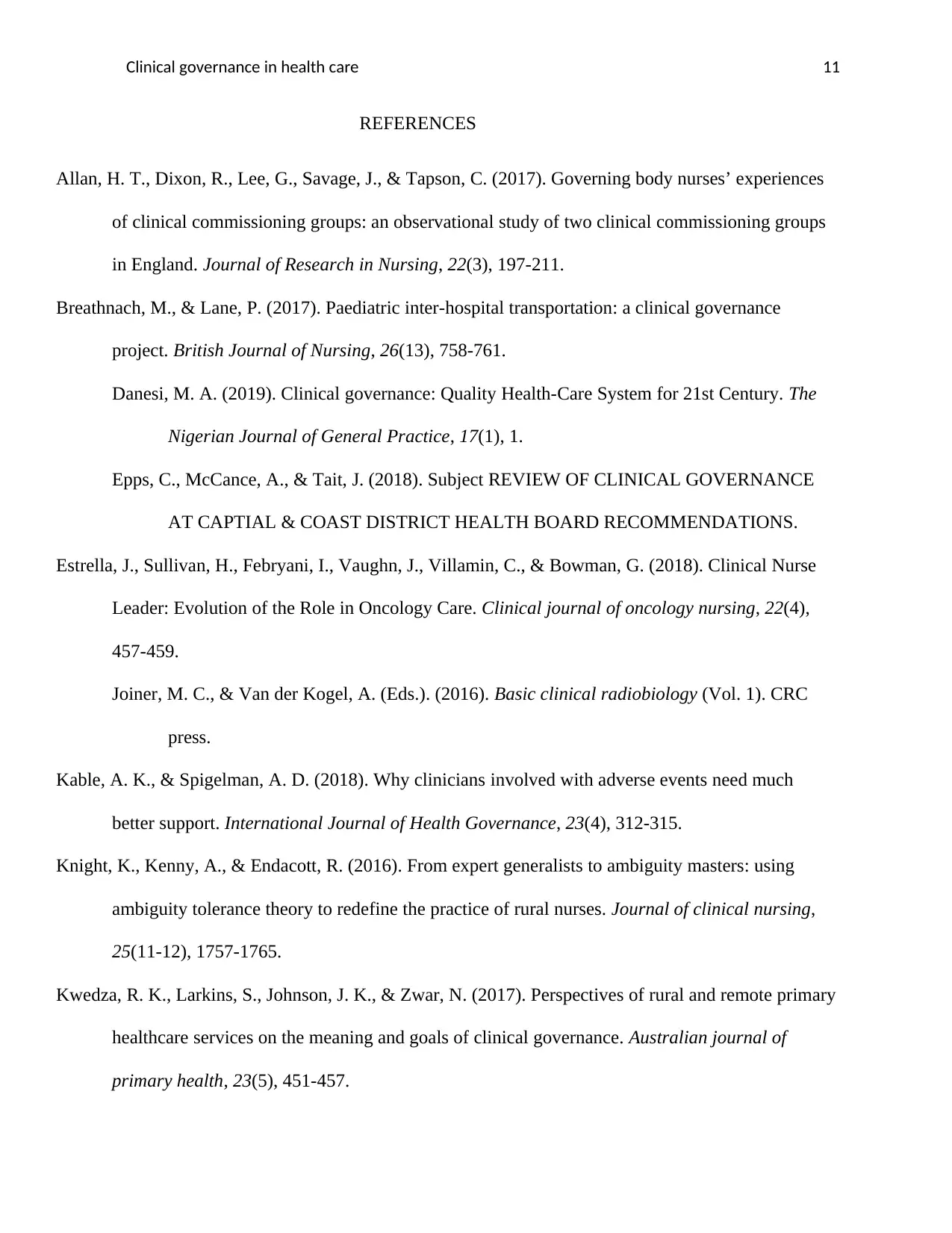
Clinical governance in health care 11
REFERENCES
Allan, H. T., Dixon, R., Lee, G., Savage, J., & Tapson, C. (2017). Governing body nurses’ experiences
of clinical commissioning groups: an observational study of two clinical commissioning groups
in England. Journal of Research in Nursing, 22(3), 197-211.
Breathnach, M., & Lane, P. (2017). Paediatric inter-hospital transportation: a clinical governance
project. British Journal of Nursing, 26(13), 758-761.
Danesi, M. A. (2019). Clinical governance: Quality Health-Care System for 21st Century. The
Nigerian Journal of General Practice, 17(1), 1.
Epps, C., McCance, A., & Tait, J. (2018). Subject REVIEW OF CLINICAL GOVERNANCE
AT CAPTIAL & COAST DISTRICT HEALTH BOARD RECOMMENDATIONS.
Estrella, J., Sullivan, H., Febryani, I., Vaughn, J., Villamin, C., & Bowman, G. (2018). Clinical Nurse
Leader: Evolution of the Role in Oncology Care. Clinical journal of oncology nursing, 22(4),
457-459.
Joiner, M. C., & Van der Kogel, A. (Eds.). (2016). Basic clinical radiobiology (Vol. 1). CRC
press.
Kable, A. K., & Spigelman, A. D. (2018). Why clinicians involved with adverse events need much
better support. International Journal of Health Governance, 23(4), 312-315.
Knight, K., Kenny, A., & Endacott, R. (2016). From expert generalists to ambiguity masters: using
ambiguity tolerance theory to redefine the practice of rural nurses. Journal of clinical nursing,
25(11-12), 1757-1765.
Kwedza, R. K., Larkins, S., Johnson, J. K., & Zwar, N. (2017). Perspectives of rural and remote primary
healthcare services on the meaning and goals of clinical governance. Australian journal of
primary health, 23(5), 451-457.
REFERENCES
Allan, H. T., Dixon, R., Lee, G., Savage, J., & Tapson, C. (2017). Governing body nurses’ experiences
of clinical commissioning groups: an observational study of two clinical commissioning groups
in England. Journal of Research in Nursing, 22(3), 197-211.
Breathnach, M., & Lane, P. (2017). Paediatric inter-hospital transportation: a clinical governance
project. British Journal of Nursing, 26(13), 758-761.
Danesi, M. A. (2019). Clinical governance: Quality Health-Care System for 21st Century. The
Nigerian Journal of General Practice, 17(1), 1.
Epps, C., McCance, A., & Tait, J. (2018). Subject REVIEW OF CLINICAL GOVERNANCE
AT CAPTIAL & COAST DISTRICT HEALTH BOARD RECOMMENDATIONS.
Estrella, J., Sullivan, H., Febryani, I., Vaughn, J., Villamin, C., & Bowman, G. (2018). Clinical Nurse
Leader: Evolution of the Role in Oncology Care. Clinical journal of oncology nursing, 22(4),
457-459.
Joiner, M. C., & Van der Kogel, A. (Eds.). (2016). Basic clinical radiobiology (Vol. 1). CRC
press.
Kable, A. K., & Spigelman, A. D. (2018). Why clinicians involved with adverse events need much
better support. International Journal of Health Governance, 23(4), 312-315.
Knight, K., Kenny, A., & Endacott, R. (2016). From expert generalists to ambiguity masters: using
ambiguity tolerance theory to redefine the practice of rural nurses. Journal of clinical nursing,
25(11-12), 1757-1765.
Kwedza, R. K., Larkins, S., Johnson, J. K., & Zwar, N. (2017). Perspectives of rural and remote primary
healthcare services on the meaning and goals of clinical governance. Australian journal of
primary health, 23(5), 451-457.
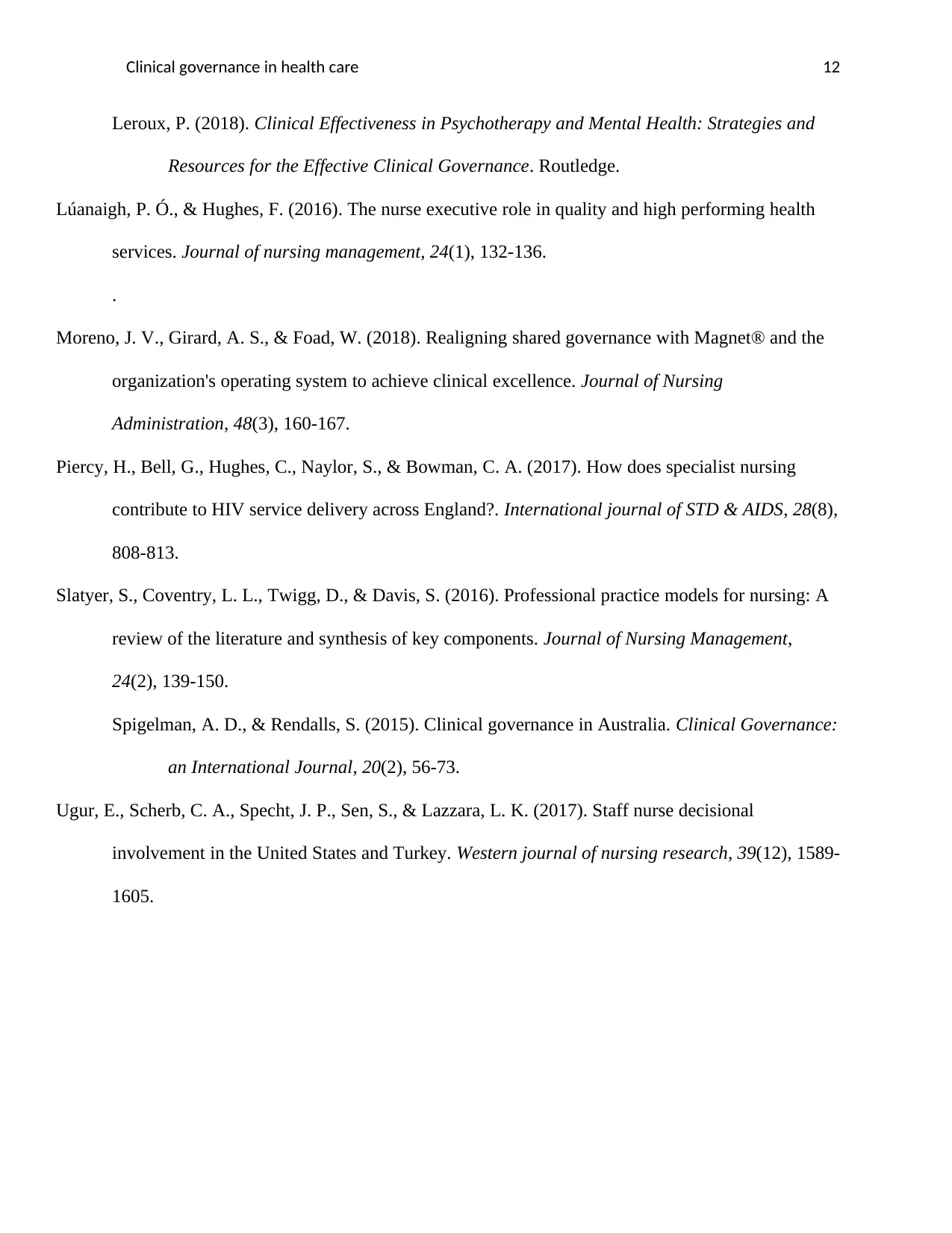
Clinical governance in health care 12
Leroux, P. (2018). Clinical Effectiveness in Psychotherapy and Mental Health: Strategies and
Resources for the Effective Clinical Governance. Routledge.
Lúanaigh, P. Ó., & Hughes, F. (2016). The nurse executive role in quality and high performing health
services. Journal of nursing management, 24(1), 132-136.
.
Moreno, J. V., Girard, A. S., & Foad, W. (2018). Realigning shared governance with Magnet® and the
organization's operating system to achieve clinical excellence. Journal of Nursing
Administration, 48(3), 160-167.
Piercy, H., Bell, G., Hughes, C., Naylor, S., & Bowman, C. A. (2017). How does specialist nursing
contribute to HIV service delivery across England?. International journal of STD & AIDS, 28(8),
808-813.
Slatyer, S., Coventry, L. L., Twigg, D., & Davis, S. (2016). Professional practice models for nursing: A
review of the literature and synthesis of key components. Journal of Nursing Management,
24(2), 139-150.
Spigelman, A. D., & Rendalls, S. (2015). Clinical governance in Australia. Clinical Governance:
an International Journal, 20(2), 56-73.
Ugur, E., Scherb, C. A., Specht, J. P., Sen, S., & Lazzara, L. K. (2017). Staff nurse decisional
involvement in the United States and Turkey. Western journal of nursing research, 39(12), 1589-
1605.
Leroux, P. (2018). Clinical Effectiveness in Psychotherapy and Mental Health: Strategies and
Resources for the Effective Clinical Governance. Routledge.
Lúanaigh, P. Ó., & Hughes, F. (2016). The nurse executive role in quality and high performing health
services. Journal of nursing management, 24(1), 132-136.
.
Moreno, J. V., Girard, A. S., & Foad, W. (2018). Realigning shared governance with Magnet® and the
organization's operating system to achieve clinical excellence. Journal of Nursing
Administration, 48(3), 160-167.
Piercy, H., Bell, G., Hughes, C., Naylor, S., & Bowman, C. A. (2017). How does specialist nursing
contribute to HIV service delivery across England?. International journal of STD & AIDS, 28(8),
808-813.
Slatyer, S., Coventry, L. L., Twigg, D., & Davis, S. (2016). Professional practice models for nursing: A
review of the literature and synthesis of key components. Journal of Nursing Management,
24(2), 139-150.
Spigelman, A. D., & Rendalls, S. (2015). Clinical governance in Australia. Clinical Governance:
an International Journal, 20(2), 56-73.
Ugur, E., Scherb, C. A., Specht, J. P., Sen, S., & Lazzara, L. K. (2017). Staff nurse decisional
involvement in the United States and Turkey. Western journal of nursing research, 39(12), 1589-
1605.
⊘ This is a preview!⊘
Do you want full access?
Subscribe today to unlock all pages.

Trusted by 1+ million students worldwide
1 out of 12
Related Documents
Your All-in-One AI-Powered Toolkit for Academic Success.
+13062052269
info@desklib.com
Available 24*7 on WhatsApp / Email
![[object Object]](/_next/static/media/star-bottom.7253800d.svg)
Unlock your academic potential
Copyright © 2020–2025 A2Z Services. All Rights Reserved. Developed and managed by ZUCOL.




